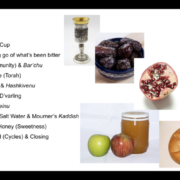[youtube https://www.youtube.com/watch?v=lwH0sNVtr9s]I gave my sermon “live” on Zoom in realtime, and also pre-recorded it to go live with this blog post around the time I was offering it. If you prefer to watch the sermon, it’s above (and here on YouTube.) If you prefer to read it, the text appears below.
The first things I saw on the tarmac at José Martí international airport were palm trees and military vehicles. That’s when my friend Rabbi Sunny, the head of Cuba America Jewish Mission, reminded us not to photograph soldiers — in fact, not to photograph anything at all until we had cleared the airport, just to be on the safe side. Right, I thought. I’m in a Communist country. Note to self, don’t photograph the army.
Last November, with Temple Beth-El of City Island in the Bronx and with Cuba American Jewish Mission, some CBI members and I spent ten days traveling around Jewish Cuba, from Havana to small cities and towns across the countryside.
Everywhere we went, we brought bags of medical supplies: everything from aspirin, vitamins, and prescription medications to anti-fungal cream and tubes of toothpaste. The synagogues there run pharmacies, and they make these pharmacy supplies available to anyone in need, whether or not they are Jewish. When we arrived, there had not been a mission like ours in six months, and their pharmacy shelves were close to bare.
Havana is incredibly beautiful. The sea crashes up against the wall on the Malecon, the main thoroughfare. One day we saw people clustered at that wall, throwing roses into the sea in remembrance of Camilo Cienfuegos, who died in a plane crash over the sea after the revolution. The sunlight was golden on stately buildings with sometimes cracking plaster and peeling paint. There was extraordinary music, everywhere. Young musicians there learn music on the state’s dime; they play in bands and on rooftops and in the streets. It’s facile to say that when one lives with hardship, the gifts of music and of spiritual life are more palpable. But I kept having that thought anyway.
As we moved deeper into the countryside, we started to encounter people who would come up to us with a hand out. They weren’t asking for money. They were asking for soap or shampoo. Everyone in Cuba is guaranteed health care, which is pretty extraordinary. But once we left the city for the provinces, a lot of people didn’t have soap. “Rite Aid or Walmart is like a fantasy to us,” said one person who had traveled abroad and had seen American big-box stores and pharmacies.
I’ve thought of that often since the pandemic began. And when Stop and Shop in North Adams started running out of things, early-ish in the pandemic — you remember: for a while there, we couldn’t buy flour, or dried beans, or toilet paper — I thought of the mostly-empty shelves in the Cuban stores we visited.
In the spring when here in the US we faced simultaneous food shortages and produce rotting in the fields, I remembered stories of Cubans going hungry after the Soviet Union fell. They told us about eating grass to try to fill their bellies while citrus fruits rotted in the fields because there was no gasoline to transport them. And I thought of how our Cuban cousins must be doing now, as the combination of pandemic and trade embargo keeps their shelves even emptier, and keeps their Jewish cousins from abroad away, with our tzedakah and our care and our desperately-needed duffel bags of aspirin and soap.
And yet when I think of the Cuban Jews we met last fall, what I remember is not what they didn’t have, but what they did: their warmth and their kindness, their connectedness and their pride. I remember the music, everywhere. I remember their beautiful synagogue sanctuaries: the Patronato in Havana, which seemed plucked right out of the 1960s just like the classic cars that serve as taxis, and the beautiful little painted synagogue in Santa Clara where we celebrated the coming-of-age of a Cuban bat mitzvah — rebuilt with tzedakah from the Cuba America Jewish Mission and travelers like us.
Most of all, I remember their love. One day we visited Rebecca Langus in the provincial city of Cienfuegos. The entire Jewish community there is eighteen people. They meet for services in her living room, on white monobloc plastic chairs that otherwise sit stacked on her tiny mirpesset next to her laundry line. She teaches the Hebrew school, which is currently three children, using books donated by Jewish visitors from abroad, like us. She works tirelessly to keep her community alive. After her prepared remarks, the four rabbis on the trip chatted with her. We asked her how she does it, and what gives her hope.
“Everything I do, I do for love,” she said simply. That could not have been more clear: her love for her community, for our shared traditions, for Jewishness itself, shone from her like light.
She told us that when they meet for Shabbat, they always have a minyan. I thought: there are only fifteen Jewish adults in this city of 150,000. Two-thirds of the Jews in town need to show up if anyone is going to say kaddish. And… they do. And if there is a fuel shortage, which often there is, they catch a ride on a donkey-pulled cart, or they walk. Because of love: for our traditions, for community, for each other.
Love brought the Jews of Cuba together to celebrate a bat mitzvah while we were there. Many walked miles, some for days, because new US sanctions had contributed to another fuel shortage. Our tour bus was able to secure fuel, but most locals weren’t. So they walked. Because it was worth it to them to be there for each other.
I felt that same extraordinary sense of community love on our final stop in Cuba, the Spanish colonial city of Camagüey. That community meets in a rented house, where they have a beautiful tiny sanctuary with a hand-painted ark, and a little social hall where we gathered to learn from them and to share songs together. There are 32 people in the Jewish community there. We sang “Am Yisrael chai” — the people of Israel yet lives! — which took on a new poignancy there, where for so long the state forbade the practice of any religion at all.
That visit to Camagüey was our last day of the trip, and after a meal with the community there, I listened as my friend and colleague Rabbi David — who is fluent in Spanish — asked a young man why he has chosen to stay in Cuba. His answer: sure, he could go anywhere. But the closeness of the Cuban family and community is precious. It is worth more than whatever money he could earn if he were to decide to leave.
Ten days does not make me an expert on the Jews of Cuba. (I suspect that ten years would be insufficient.) But our trip still resonates in me. The Jews I met in Cuba inspired me with how proud they are to be Cuban and to be Jewish. They inspired me in how they show up for each other. Even in a place where for so long it was illegal to practice any religion at all. They inspired me with their love for our traditions, their love for community, their love of country, their love for each other.
The Jews of Cuba live with profound hardship. That was true a year ago; it is even more true now. And yet… when the pandemic began to rage in the US, they reached out to me via Facebook to make sure that we were okay. Because their love and care flows so naturally, even toward we who have so much.
Tonight they too are hearing the words of Kol Nidre, words that release us from the vows we won’t be able to live up to. But I don’t want to be let off the hook for my promise to keep our connections alive across borders and differences. Communist or capitalist, Cuban or American, rich or poor, we are part of one Jewish family.
Because of the pandemic, it will probably be a long time before we can gather together again in person in physical space. And… the pandemic also highlights how deeply interconnected we are, even when we’re apart. Covid-19 spread around the world because the whole world is interconnected: what happens there has an impact here. What happens to me has an impact on you. This is a deep spiritual truth. It’s also a practical one.
And covid-19 is also teaching us other forms of connectedness. Over these pandemic Days of Awe, we’ve davened with members of our community who live in other places… and with far-flung friends and family who maybe never felt connected with our little shul before. What if we keep all of these connections vibrant and alive in 5781? Imagine the strength and hope and courage we could share with each other through the pandemic winter that is coming. We can be there for each other as our Cuban cousins are there for each other — and we don’t have to walk miles to do it: our connectedness is as close as the click of a computer key.
For that matter, we can be there for our Cuban cousins, too. Rabbi Sunny tells me that right now it’s almost impossible to send tzedakah to Cuba. As of this week, a wire transfer sent in July via Panama and Israel has yet to materialize, and a package of much-needed medicines has been missing for sixty days. But we can support the Cuba America Jewish Mission so that when it becomes possible to directly bring help to Cuba again, there are tzedakah dollars to bring.
Talmud teaches that all of Israel is responsible for one another. Our Cuban Jewish cousins live that truth — not because it’s in Talmud, but just because of who and how they are. This Yom Kippur, may we find uplift in the knowledge that under unbelievably difficult circumstances they are praying these words with us too. May we go the extra mile to be there for each other in community, as do our Cuban cousins. And may we find uplift in the knowledge that we share one tradition; that we share one heart; that love connects us all.
This is Rabbi Rachel’s Kol Nidre sermon (cross-posted to Velveteen Rabbi.)



















